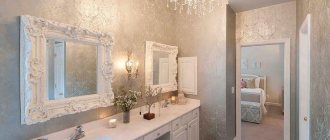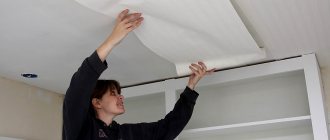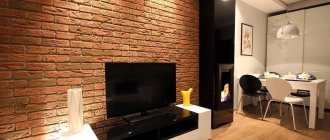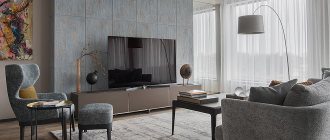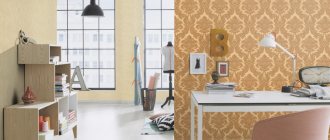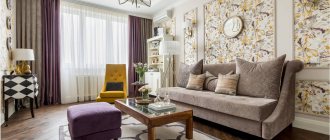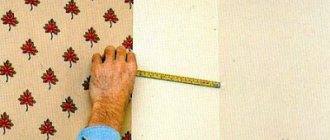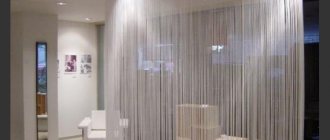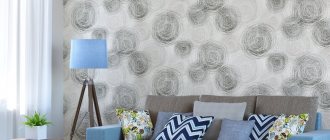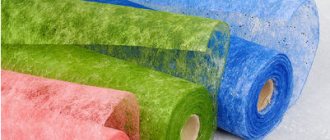About the advantages and disadvantages
The advantages of finishing include:
- harmony with any style;
- a huge range of textures, shapes and colors;
- originality;
- easy maintenance and long service life;
- decorating walls in this way will not be difficult;
- the stone is not susceptible to infection by fungal growths;
- environmental friendliness;
- light weight.
Cons of artificial stone:
- shorter service life compared to natural materials;
- some samples made of soft material quickly take on a shabby appearance;
If you correctly select this decorative element, then the listed shortcomings will remain in the shadows. To protect it from negative environmental influences, its surface is treated with a special impregnation or varnished.
How is gypsum wallpaper installed?
Once the wall and tiles have been treated with acrylic, you can begin installing stone wallpaper. The tiles must be laid on adhesive mastic, which must be thick enough. Using a notched trowel, mastic is applied to the wall surface in a layer of 2 mm. To prevent the glue from drying before placing the tiles on it, you should not smear a large area of the wall with a spatula in advance. Typically, the adhesive solution is placed on 0.5-1 sq.m of vertical surface. Next, tiles of stone wallpaper are laid on it.
Related article: How to assemble a loft bed: instructions and operating procedure
The tiles are laid on adhesive mastic, which should be very thick.
Installation can be done using either a jointed or seamless method. With the jointing method of laying, pieces of tile are glued to the wall at a short distance from each other. With the seamless method, the pieces of gypsum must either fit tightly against one another or be connected by grooves. In the latter case, there will be more work, since you will need to constantly adjust the pieces to each other, cutting out grooves with a hacksaw. Sometimes owners alternate rows of gypsum stone: one row of tightly fitted tiles, the other a groove joint. These wallpapers look very interesting. Much more often people prefer to glue stone wallpaper using the stitching method.
Plaster elements should be placed on the wall in horizontal rows either from top to bottom or from bottom to top - whichever is more convenient. Each row must be checked for level. The distance between the seams should not be strictly the same, this will give a natural look. It is advisable to start installation from the corners. In order to connect the plaster pieces at the corner, carefully cut grooves in the corner tile elements with a hacksaw, and then connect them to each other with a “lock”.
The artificial stone is pressed tightly but carefully onto the surface greased with glue so that part of the mastic frames each tile on all sides. This will contribute to excellent sealing of the seams. Excess solution can then be removed. However, you should not allow mastic to get on the front side of the tile, as removing it from there will be problematic.
To protect the surface from water and external influences, it is necessary to cover the stone wallpaper with a water-repellent composition.
When the gypsum wallpaper is glued to the wall and the mastic itself on the seams has hardened a little, you will need to rusticate the seams to give them a neater look. A wooden spatula of a certain shape is suitable for this purpose. It is carefully passed along the seam filled with mastic mixture, leveling it. But if there was little adhesive solution and it does not protrude from under the tile, then you will need to fill the seams with additional mastic.
Related article: Beautiful DIY curtain holders
This operation is performed using a special bag into which the adhesive mixture is placed, and then the mastic is carefully squeezed out of the hole into the space between the gypsum tiles. After rustication and drying of the adhesive solution from the front surface of the stone wallpaper, you will need to carefully remove any mastic that has gotten on it with a dry brush.
In order to protect the cladding surface from water and mechanical influences, it is necessary to additionally coat the stone wallpaper with a solvent-based water-repellent composition. It is applied to the wall with a household spray gun. This measure is necessary in houses with high humidity and rooms where pets or children often come into contact with the walls. Thus, it is not difficult to stick stone wallpaper on the wall, and the result will please not only the owners, but also their guests.
The best posts
- How to make a plasterboard ceiling in the kitchen with your own hands
- Painting drywall - step-by-step instructions
- How to join drywall in corners and the process of building a decorative niche
- Sealing drywall joints - recommendations from professionals
- Epoxy resin, application
- How to seal a doorway with plasterboard - installation diagram
- DIY plasterboard ceiling installation - video tutorials and installation instructions
- How and how to glue a foam plastic ceiling plinth
Combining artificial stone with wallpaper
Decorative stone is unique in all respects, and any type of wallpaper will harmonize with it. To ensure they last a long time, you should choose high-quality fabrics. Liquid wallpaper is perfect for the hallway.
You can also use paper, non-woven or glass wallpaper.
Paper material is cheap, easy to stick to walls, and can be painted well.
Non-woven wallpaper has a porous structure, making it easy to hide any unevenness or cracks. They are also durable and can withstand staining well.
Fiberglass wallpaper combines favorably with decorative stone, as it has a relief surface.
Photo wallpapers will look good. It is important that they match the selected stone as closely as possible.
Advantages of using decorative stone in the interior of an apartment
Most often, decorative stone is used in finishing external facade surfaces on buildings, gazebos and columns. Using this material, a stone niche is made, and you can also line the area around windows or doorways with natural or artificial material. However, in recent years, stone has been increasingly used as decoration for the interior of residential premises, due to the following advantages:
- high levels of environmental cleanliness;
- absolute fire resistance and fire safety;
- excellent resistance to negative mechanical influences;
- significant wear resistance of the resulting coating;
- resistance to excess humidity;
- long service life;
- non-susceptibility to changes due to temperature changes;
- simplicity and ease of care;
- wide selection of design solutions.
The use of decorative stone in apartment decor allows you to get the maximum feeling of coziness and comfort. However, in small apartments, such a cladding option is undesirable, due to the ability of such material to visually reduce the size of the premises.
Color solutions
Most often, beige, gray or brown shades are used in modern hallway design.
To visually enlarge the space, use light shades that imitate marble, granite, quartz or pebbles.
It is better to choose light wallpaper for a dark stone finish.
The best option would be if the wallpaper is two shades lighter than the stone.
Various bright colors are also relevant.
The use of decorative finishing stone in the interior of an apartment
The stone is environmentally friendly and durable, therefore it is actively used in the interior. A wide range of colors, textures and prices makes it possible to use this material in the decoration of residential premises, and high results can be achieved by following the following recommendations:
- You can effectively emphasize the natural original texture of artificial or natural decorative stone through a properly equipped lighting system in the room;
- The combined finishing using natural stone and warmer materials such as furs, cashmere, carpets and fluffy pillows looks very interesting and unusual;
- to give the cladding of the apartment warm shades and make the home atmosphere more lively, it is necessary to add warm tones and shades, represented by yellow, red and orange, to the cladding;
- the natural beauty of natural materials can be successfully emphasized by focusing on the joints of masonry using contrasting shades;
- in rooms that are not spacious enough, stone cladding, as a rule, is performed only on a separate part of the wall surface, which prevents the decor from being overloaded with heavy materials and makes the interior easier for visual perception;
- The combination of wall decor with stone and ceiling decoration with the same natural or artificial material looks unusual and very stylish;
- Painting masonry allows you to improve the texture and textural characteristics of the finish, and also makes the cladding more harmonious and soft.
Stone wall cladding can complement almost any interior design, traditional or modern.
Stone wall decoration can complement the interior design of almost any traditional and modern style, but it is necessary to choose the right type of natural or artificial stone that is optimal for each specific case.
It should be noted that recently brickwork has become particularly popular in the decoration of residential premises, which ideally complements the design of lofts and interiors in a modern style. Finishing with large natural and artificial stone segments of various shapes is perfect for interior decoration in a rustic style.
Recently, brickwork has become especially popular in the decoration of residential premises.
Styles
The hallway creates the first impression of the home, and therefore it is very important to choose its design. Let's consider design options that use the “stone + wallpaper” duo.
Modern style . Chooses white stone to match the brick and light wallpaper.
Eco style . Slate rocks are used here.
Urbanism . Uses brick-like tiles.
Classic . Decorates the walls with marble or granite.
Country and Provence . They use gray and brown stones of different shapes. Combined with regular wallpaper, photo wallpaper and murals.
It is not uncommon to add “street lamps” to such an interior.
Combining stone wallpaper
As has already become clear, stone wallpaper cannot always exist on its own. Therefore, the question arises, what can such colorful walls be combined with?
If you want to create a sophisticated, sophisticated interior, then wallpaper from the Stone Flower collection is a win-win option. They are almost universal and suitable for the decor of any room. In addition, manufacturers of finishing materials greatly simplify the task by producing wallpaper in several formats of the same color scheme - “flower” and plain.
You can purchase Stone Flower wallpaper from a wide variety of materials. The cheapest material is paper, the most expensive is vinyl and non-woven fabric.
The rich texture allows you to combine this design with plain, painted walls. Moreover, the room does not look poor or not fully thought out:
It is better to use a calm palette; neon, contrasting shades in this case will seem inappropriate.
The beauty of stone is its natural origin, in the case of wallpaper, even if only visual. This means that in the interior you can use any natural materials or those made to resemble them. Wooden furniture, floors, ceilings, accessories will create a good tandem.
The room can be decorated with vegetation, potted plants of any size. And even one flower can add freshness, as in the photo below:
Interesting ideas
So, let's see what we can do to unusually decorate the walls with decorative stone and wallpaper in the hallway?
- Apply jagged edges to make the walls look voluminous.
- Install spotlights to highlight the cladding.
- Add various decorations to the wall. Mirrors, paintings, fakes and compositions will be used.
- Create a living corner.
- In the classical direction, place stone on the columns, emphasizing the overall ambiance.
- Hang shelves to store small items.
Stone-like wallpaper in the bedroom
Despite some roughness, the stone looks great in the bedroom interior. According to psychologists, such walls symbolize reliability and instill a sense of calm and security. It is behind such walls that you can hide from the outside world and truly relax. It is not surprising that you can increasingly see stone wallpaper in bedroom design:
Of course, it’s not often possible to see a room completely covered with such wallpaper. Still, this option is more suitable for spacious areas:
But it is used quite often to decorate the bedside area:
Moreover, it is possible to use this design for the interior of a bedroom of any style - from modern to classic. Naturally, for a classic design, an image of decorative stone or artificial brick is better suited.
White wallpaper gives a solemn look and makes the bedroom brighter and more spacious:
A rougher-looking material, natural shades and shapes, perfectly emphasizes the simplicity and originality of the most shocking fusion style. Here, in the interior, incompatible things can be found - an antique column and high-tech furniture, Baroque stucco and modern metal structures. Stone can enhance contrast, emphasizing the rebellious spirit in the interior:
Artificial stone on the arch
A popular option for using stone in the interior of a hallway is lining the passage to different rooms with stone. Using your imagination, you can choose the best option for yourself.
The decoration of the opening looks exclusive if the brick meets the wall in places.
The arch can be made in any color and style.
You can line one side of the passage with stone.
Or surround it with stones.
Stone-like walls in the living room
For several years now, designers have been using stone-effect wallpaper to zone rooms. In the living room, stone wallpaper is often used to decorate the wall on which the TV is located, as in the photo:
More often they use a material that imitates artificial stone, which has a more uniform image and clear shape.
An interesting option is the Stone Flower wallpaper, which is distinguished by its unique beauty and simplicity. Imitating stone, these canvases make the interior more elegant:
Stone flower wallpaper can be used to design any room, but more often they can be found in the design of living rooms and bedrooms. This is due to their more uniform color and regular pattern, while the cost of such wallpaper is low.
Stone-effect wallpaper, including the “Stone Flower” collection, is used to decorate a recreation area in which sofas, armchairs, and couches are located:
These wallpapers look great in the interior of a living room with a fireplace. The hearth has always been a symbol of family warmth and comfort, which is why it is installed not only in country houses, but also in apartments. And it doesn’t matter whether it’s a real fireplace or an electric one, it goes perfectly with walls decorated to look like stone.
Photo examples in real apartments
Below are a few successful examples of corridor renovations by ordinary people who chose this finish for themselves.
Is it possible to glue decorative stone to wallpaper?
How to glue decorative stone to walls, video, instructions
The use of decorative stone has no strict restrictions. The variety of shapes, textures, shades, high performance and physical characteristics allow it to be used for both interior and exterior decoration. These qualities are especially highly valued in wall cladding. The main thing is to make the right choice of material and follow the rules for its fastening.
Types of decorative stone
The material can be of artificial or natural origin. Natural decorative stone, which includes marble, onyx and others, is distinguished by its heavy weight and high cost. Not every wall can withstand such cladding. Therefore, most often, artificial stone on a gypsum or cement base is used for finishing.
Gypsum tiles do not tolerate moisture well and are not recommended for use in bathrooms and kitchens. Stone with a cement base, on the contrary, will be an excellent choice for these rooms. Wall cladding is usually done with medium-sized stone that imitates brick or slate.
Selecting consumables
Finishing of stone on a cement base is done with an adhesive mortar containing cement, and on gypsum - with mastic, tile adhesive, or a cement-sand composition. PVA glue is suitable for cladding plasterboard and wooden walls. The wooden surface is treated with an antiseptic before gluing the stone.
The color of the grout for the joints is selected to match the shade of the stone. The finish using slate decorative stone turns out to be monolithic. The tiles are coated with acrylic impregnation or water-based varnish. This protects the material from negative influences and increases its decorative effect.
Cladding of plasterboard and wallpapered walls
It is not recommended to glue this facing material to wallpaper. First, the walls are trimmed with stone, and then wallpaper is pasted. The slabs of the side rows are glued in such a way that they overlap the wallpaper by no more than 2 cm. If the walls are already covered with wallpaper, some of the canvases are removed for finishing with stone.
Plasterboard walls can withstand loads from 10 to 60 kg per 1 m2. This allows you to stick decorative stone slabs on them, which are lightweight. To ensure reliable fastening, many experts recommend reinforcing the structure with reinforcing mesh. Especially when the load per 1 m2 will be 30 kg or more.
Preparing walls and mixing mortar
Decorative stone is glued only to the prepared base. The walls must be smooth, solid and durable. All old coating is removed from their surface, stripping it down to the base. This also applies to particles of dust, dirt, traces of various solutions and oil stains.
The walls are puttied, plastered and primed. If work is carried out in the summer, when the temperature rises above +30 degrees, the walls are moistened with water. It is also better to prime the slabs on the inside. This increases their degree of adhesion to the base.
The adhesive solution is prepared in accordance with the instructions. It sets quite quickly, so it is better to mix it in small portions, given that the consumption per 1 m2 of stone is about 6 kg. If the glue is prepared from a dry mixture, uniformity can be achieved using an electric drill.
Laying order
Rectangular slabs are glued in rows, oval slabs - in random order. Elements of non-standard shape are first laid out in the desired pattern on the floor. This allows you to transfer it to the wall surface.
Slabs of different sizes should be alternated, changing the sequence in each row. To create a masonry effect using elements of the same size, the first tile of the second row is cut. This ensures that the seams between the rows do not match. Cut the slabs with a hacksaw or miter box.
You can start laying stones both from above and from below. If the wall is covered over its entire height, it is better to glue the elements from the ceiling. In this case, the cut tiles will be at the bottom and will not be noticeable.
Gluing decorative stone
The glue is spread on the wall with a flat spatula and a thin layer on the back side of the decorative element. Small sides are formed on the sides of the tiles and the solution is additionally applied pointwise. The tiles are pressed against the wall and leveled with a building level.
To hold the stone tighter, lightly tap it with a mallet. Exposed adhesive must be removed immediately. To do this, you can use a damp sponge or rag. It is almost impossible to remove most solutions in their frozen form without leaving traces.
These steps are repeated with each element, laying out the entire wall or a separate section of it. Corner slabs are cut at an acute angle.
The final stage is grouting the joints. They are filled using a pastry syringe or a special bag. The top of the stone is coated with varnish or impregnation.
Video: How to glue decorative stone to walls
Similar articles: Decorative stone for wallpaper Preface
Nowadays, quite often, combined finishing materials have begun to be used when decorating the interiors of apartments. One of the most common options, especially for the hallway, is decorative stone. Thanks to a number of advantages, it is becoming increasingly popular both among ordinary buyers and among representatives of companies involved in finishing apartment interiors. So, decorative stone with wallpaper in the hallway: is it possible to glue such materials in combination with each other? What are the main advantages of using such combinations? Let's try to figure it out in more detail.
Good to know! This material is environmentally friendly and safe for the health of residents. It is highly resistant to mold and mildew, and is not susceptible to decomposition and corrosion.
Scope of application of the material
So, let's look at exactly which rooms of an apartment or country cottage can use this type of interior decoration.
In most cases, it is used for complex finishing of places such as:
- Kitchens and dining rooms.
- Hallways (corridors).
- Halls (living rooms).
It is worth noting the fact that for decorating rooms, both the simultaneous decoration of the hallway with wallpaper and decorative stone (a combination of these materials) and the use of the latter as the main material can be used. In many ways, the decision to choose an option for interior design is a reflection of the aesthetic preferences of the apartment owners. We should not forget that in addition to walls, artificial stone, as well as its various varieties, can be used not only when arranging walls and internal partitions, but also when decorating ceilings, especially in cases where it is necessary to correctly select companion colors for the interior rooms.
Main types
So, now let's look in a little more detail at what types of decorative stones are presented on the market of construction and finishing materials in Russia and the CIS countries. In general, if we talk about the origin of the raw materials used in production, we can distinguish two main groups of stones for interior cladding:
- Artificial origin.
- Natural, which are mined in appropriate places.
- Granite. An expensive stone that will fit perfectly with classic interiors.
- Sandstone. In addition to fairly simple installation, which you can do yourself with your own hands, it is distinguished by a variety of color options. So, you can choose from the following colors: brown, red and green.
- Limestone. This material is known for its ease of processing and interesting texture.
- Marble. Its main advantage is its beautiful and rich-looking appearance, which is suitable for interior decoration of expensive and luxurious interiors.
Let's look at each of these varieties in more detail.
Natural materials
Natural materials include such varieties as:
Be that as it may, most natural stones have a fairly high price. Incl. and for this reason, it is quite rare to find them when decorating the interiors of hallways in an apartment. In addition, such materials, as a rule, are characterized by a fairly large weight, which makes their installation more problematic compared to lightweight artificial analogues. In addition, not every partition will be able to withstand such a high mass.
Artificial analogues
Be that as it may, these beautiful, but at the same time quite expensive and massive materials have an excellent alternative: artificial decorative stone of various types.
It has a number of significant advantages:
- In terms of weight, it is 50-100% inferior to natural analogues.
- In appearance it is almost as good as them.
- It has a more affordable price.
- Has high strength indicators.
If we talk about the most common materials on the basis of which such stone is produced, then these are, first of all, gypsum and cement. As for cement tiles, they withstand high levels of humidity quite well, which makes it possible to widely use them in apartment spaces such as the kitchen, dining room, bathroom, etc.
On the other hand, if we talk about decorative stone made on the basis of gypsum, then it has both advantages and some disadvantages. So, despite a very attractive appearance, as well as a wide variety of configurations, this type of interior decoration is characterized by poor resistance to high levels of humidity in the room. That is why the optimal places for its use are the living room, hallway (corridor), bedroom.
By the way, one of the tasks set for high-quality and attractive artificial stone is the imitation of various materials, primarily of natural origin. It is this approach that makes it possible to create a variety of styles when decorating the interior, and also allows you to combine stone with wallpaper, expanding the possibilities for a variety of combinations. Among the most popular options for simulations today are the following:
How to make installation
Recently, the decision to glue decorative stone to wallpaper has become very popular. Gluing it is not that difficult. However, most people do not have experience in carrying out interior decoration work in an apartment or country house. Some of them even wonder whether it is possible to glue decorative stone to wallpaper?
So, let's look at what happens when decorative stone is glued to various types of wallpaper, under certain circumstances. Let's highlight the most common of them:
As we can see, in both cases certain difficulties may arise. However, even in such cases it is possible to find fairly rational solutions that allow you to find a way out of the situation. Find out how to stick decorative stone on wallpaper, or find some other alternatives, just below.
Alternative methods
So let's look at some other mounting options.
Decorative panels are glued first
You can put the stone at the beginning, or to be precise - even before wallpapering. In this case, you will need to remember that the tiles that are on the edge and, thus, are a kind of line of contact with the wallpaper, do not need to be glued. In other words, the next stage is wallpapering. At the same time, some of them should go exactly to these areas bordering the stone. And only after this the final laying is done, and the decorative tiles (its outermost rows, which we did not glue at the very beginning) are glued to the wallpaper.
Attention! When working with liquid wallpaper, these instructions will not help you, since in its structure, as well as in its installation technology, liquid wallpaper is much closer to plaster than to the more common paper, textile or vinyl sheets.
Brief instructions look like this:
First the wallpaper is pasted
However, there is another way. Its brief description: first of all, you glue the wallpaper, and you need to glue it throughout the room, as usual. After this, you determine the areas where the tiles will later be located and cut them out using a sharp knife or blade. The wall surfaces must be prepared. And after this, the decorative stone is installed on top of the wall. In addition, this option is suitable for cases where the wallpaper has already been hung.
Let's look at how to do this correctly:
Attention! After you finish installing artificial or natural panels in the hallway (corridor), or in other places in the apartment, it is advisable to treat them using a special colorless varnish that has protective properties.
Don't miss this interesting video:
So, as a conclusion, we can say that if you want to stick a decorative stone on top of the wallpaper, feel free to do so. However, when carrying out work, it is necessary to follow certain instructions, since, otherwise, part of the wallpaper may be damaged as a result of exposure to the adhesive, or the connection will not be strong and reliable. Happy renovation!
Stone wallpaper: under stones, photos in the interior, with your own hands, is it possible to glue decorative stone, artificial, imitation for walls,
Stone wallpaper: a piece of original nature in every home
The appearance of stone wallpaper is particularly aesthetic. Some time ago, paper wallpaper created a real revolution in the world of design: people began to decorate the walls of their home with various designs and patterns, this turned into real art. There is no denying that over the past hundred years, paper wallpaper has indeed been the most popular finishing material in the interior. At some point, many designers realized that paper wallpaper is no longer so interesting and unusual: in almost every apartment you can find paper wallpaper. Since the most important thing for a creative person is the unusualness and exclusivity of his work, many designers began to look for a new solution for finishing wallpaper, experimenting with various materials. And one wonderful day, stone wallpaper was introduced to the world. Such a stone wall will look great in any interior.
Stone wallpaper in the interior: a bold solution for creative people
Stone wallpaper is a very thin layer of artificial stone, made in the form of tiles. The thickness of such wallpaper does not exceed 15 millimeters: they are quite easy to install with your own hands, and they are more durable than their paper alternative. If we consider the differences from conventional artificial stone finishing, the advantages of wallpaper are that they are much cheaper: unlike stone finishing, even people with average incomes can afford to buy stone wallpaper.
Stone wallpaper does not ignite even in direct contact with fire
Stone wallpaper can be installed on any surface because it is very light.
Stone wallpaper does not have any external corner elements, which allows you to install stone wallpaper like regular tiles. As a rule, stone wallpaper is made of gypsum: this material is famous for its strength and durability. Consequently, they are not afraid of either wet cleaning or strong impacts. As you know, decorative artificial stone is quite cold to the touch: unlike conventional decoration, stone wallpaper is warm and pleasant to the touch.
Stone wallpaper design () What is flexible stone wallpaper
Flexible stone is also an interesting solution for wall decoration. This material is based on a layer of sandstone: flexible stone can be used to decorate not only walls: this material can be used to decorate facades, arches, pools - just about anything. Flexible stone got its name because it is flexible enough to use, and you don’t have to limit yourself to just patterned wallpaper. In addition, flexible stone wallpaper can be rolled up, just like its paper counterpart.
Flexible stone is a natural finishing material
Wallpaper made of flexible stone is durable, which will save on future repairs. Manufacturers guarantee that flexible stone wallpaper will last for 20-25 years.
In addition, even if you need to wallpaper a large area, you can do it even without seams. Despite the presence of the word “stone” in the name, such material can be cut very easily using ordinary construction scissors.
Possibility of combining wallpaper and stone in the interior
If you combine a layer of wallpaper with the addition of stone, you can get an unusual composition. Decorative stones are an environmentally friendly material; they do not require special care: in addition, they are resistant to various fungi and molds.
Is it possible to glue decorative stone to wallpaper?
Many people are interested in the question of whether it is possible to glue artificial stone to wallpaper. Answer: this can be done if certain conditions are met; This type of finishing has many advantages.
Here, for example, are some of them:
Decorative stone, even light colors, reduces lighting
If you decide to glue decorative stone to the wallpaper, then you need to take into account the fact that you do not need to glue this material directly to the wallpaper. In the place where you plan to glue the stone, you should simply remove the wallpaper and any remaining glue. If irregularities are detected, the place where the stone is installed can be plastered. Once you have ensured that the wall is sufficiently smooth and clean, you can begin lining the wall with stone. To strengthen the stone and make it more attractive in the interior, it is recommended to coat it with a special varnish.
What are the advantages of wallpaper that imitates stone?
Stone wallpaper is a budget solution for people who want to achieve the effect of stone walls, but do not have enough money to afford real or artificial stone. Now there is a huge selection of different wallpapers: from cheap paper wallpapers that imitate brickwork, to expensive options that are difficult to distinguish from the original. As a rule, expensive stone wallpaper is made in several layers, which creates the effect of real material. Even if you look at such wallpaper from a close distance, it is very difficult to distinguish high-quality stone wallpaper from real stonework. The only noticeable difference is the tactile sensation. An excellent solution would be to wallpaper a stone flower - they look like a real work of art.
Alternative finishing options are becoming increasingly popular, namely wallpaper with a decorative stone look.
In any case, it is you who decide which finish will look best in your interior.
Stone wallpaper ()
It is worth starting from many factors: the characteristics of the room, budget, wishes. If you want to get a good result, then you need to try hard and spare no expense: then the result will not keep you waiting.
Stone wallpaper design (photo)
- How to glue wallpaper with customized design Auto homemade products Homemade products for the dacha Fisherman, hunter, tourist Construction, repair Homemade products from unnecessary things Radio amateur...
- Is it possible to glue wallpaper on OSB? Is it possible to glue wallpaper on OSB? Methods and procedure of work Oriented strand board is used when leveling…
- Is it possible to glue MDF panels onto wallpaper? Is it possible to glue wall panels? Liquid wallpaper fits well on SIP panels. Liquid wallpaper is…
- Is it possible to glue artificial stone to wallpaper? Artificial stone to wallpaper. Modern design Design ideas do not stand still. Its development spurs...
Common varieties
Considering the main types of finishing stone, it should be noted that they are somewhat different from each other. What exactly is the difference between them? One of the classifications is based on the origin of a particular material. So, the stone can be either natural or artificial. We will now provide a brief description of the characteristics and features of each of these types.
Fake diamond
Recently, the use of artificial stone to decorate the walls of rooms has become increasingly common. It can be used either alone or in combination with wallpaper. The growing popularity is by no means accidental, since it is due to numerous advantages. Let's list the main advantages:
- Inexpensive in price.
- It is light in weight compared to its natural “brothers”.
- Strong and durable.
Of course, artificial stone must be produced on the basis of some kind of raw material, which, in turn, is of natural origin. In most cases, cement or gypsum is used as the base. Gypsum tiles have their advantages and disadvantages, just like any other material. On the one hand, it is characterized by excellent aesthetic characteristics, which makes this material very attractive. It can be used in the hall and bedroom. On the other hand, installing this type of finishing in the corridor, as well as in the loggia and toilet (you can read about wallpaper in the toilet in more detail in this article) may raise certain questions, because withstanding high levels of moisture is not one of its strengths.
On the other hand, decorative cement stone is more resistant to use in rooms with higher moisture levels. Therefore, this coating can be safely used in the hallway, kitchen, dining room and even in the bathroom.
Imitation of other materials
Any artificial coating has one feature: it is designed, to one degree or another, to imitate one of the natural materials. Artificial stone for interior decoration is no exception. Thanks to the variety of various options offered by various manufacturers, buyers have the opportunity to select the necessary finishing surfaces for almost any interior style. In addition, we must not forget about the many possibilities for combining in the interior. Wallpaper (vinyl, paper, non-woven and other types) can also act as companions, of course.
Let's look at the most popular "samples" for copying:
- Slate. An interesting material with a unique surface allows you to create very unusual interiors, as well as combinations. Due to its appearance, the illusion of a uniform surface is created.
- Natural stone. Perhaps the most popular type of imitation. As a matter of fact, this is why the material acquired its name: artificial STONE.
- Ceramic clinker brick. The tile, which is designed to imitate real brick, can be painted in any color. In addition, its texture can also be different: from completely smooth, to rough and slightly “aged”. By the way, artificially aged materials are often used in the Provence style, which you can learn more about by reading this material.
Natural materials
So, before answering the question of whether it is possible to glue decorative stone to wallpaper, let's look at the types of materials that are of natural origin and were not made artificially from one or another raw material. A special feature of this type of wall decoration is the significant cost of both the material itself and the work required to install it correctly and beautifully. In addition, unlike some artificial analogues, it is characterized by considerable weight, which makes transporting and laying such stone more difficult tasks.
There are 4 main materials of natural origin:
- The easiest way to do the installation yourself is in cases where you use sandstone. Its common colors are green, yellowish, brown, beige, red.
- A more expensive and heavier stone that suits a more formal style is granite.
- Similar words can be said about marble, which is the optimal solution for classic interiors.
- And finally, limestone. It is, in some ways, similar to sandstone, due to its relatively simple installation and lighter weight compared to granite and marble.
Interesting to know! This material is also known as “wild stone”.
Where is stone cladding used?
Decorative stone is widely used for interior decoration and even for finishing the facades of houses. The material is strong, durable, looks great thanks to its unusual texture and abundance of colors. It can become a “highlight” and add more comfort and chic to any room.
Among the variety of decorative elements, there are those that are used exclusively to add luxury to the interior. For example, the interior looks rich and beautiful when finished with natural mineral onyx. Brick will add coziness to the kitchen. Sometimes the area behind the stove is lined with bricks, creating the illusion of a real fireplace.
The popularity of this facing is due to the following reasons:
- Resistance to aggressive environmental factors. Natural minerals and artificial materials (concrete, gypsum, etc.) are strong and durable. The exception is gypsum. It is not used for laying the walls of rooms with high humidity, since gypsum absorbs moisture well and quickly deteriorates.
- Environmental friendliness. It is recommended to lay tiles made from natural minerals or gypsum indoors, as this is more environmentally friendly, and outside – from concrete and cement.
- Easy to care for (resistance to chemicals).
Advice:
Decorative stone is mainly used to create designs in loft, country styles, and to imitate “antique” style. Tiles that imitate brick are often used to decorate the area behind the stove in the kitchen. This adds a homey feel to the kitchen area.
Slate or gypsum tiles imitating it are used to cover the wall in the dining area and corridor. The pronounced texture and elongated shape of the tiles help to visually enlarge the room.
Minerals used in interior decor include:
- marble;
- granite;
- sandstone;
- malachite;
- quartz;
- onyx;
- agate.
Natural stone is used to cover:
- ceiling;
- floor;
- walls;
- arches;
- columns;
- partitions;
- fireplaces;
- niches.
There are two main disadvantages - heavy weight and high price. Therefore, design most often uses imitation of these minerals from gypsum and other materials. Such tiles are lighter and easier to install.
Features of stone wallpaper
Despite the fact that flexible stone wallpapers are considered a new finishing material, they have rapidly gained popularity in the construction market, and today they can be found in most modern interiors.
Such wallpapers are made from gypsum or sandstone and have a textile base that ensures reliable fastening of the materials to the walls.
Since the process of creating such wallpaper is carried out on the basis of modern and highly efficient technologies, manufacturers have managed to increase their durability, strength and service life.
The main advantages of using stone wallpaper in the interior include:
- possibility of finishing both internal and external surfaces;
- resistance to moisture and temperature changes;
- high flexibility and elasticity , allowing you to adapt to any shape of walls;
- maximum strength and abrasion resistance , despite the presence of materials of different thicknesses;
- the ability to design not only wall surfaces, but also arches, columns, niches, ledges, partitions and other structures;
- environmental friendliness and breathable properties of such materials, which makes them absolutely safe for health;
- the materials included in the structure of such wallpaper are distinguished by anti-allergenic properties ;
- wallpaper of this type does not ignite even in direct contact with fire;
- The gypsum structure allows for additional sound and heat insulation in the room.
In addition to these features, it is worth paying attention to the aesthetic properties of stone coverings. Thanks to the natural structure, the appearance of your walls will always be natural and elegant.
Tip: one of the advantages of using stone wallpaper is the ability to combine it with any type of material. For example, wooden furniture, metal grilles or glass attributes will harmoniously fit into any interior, complemented by stone compositions.
Since this material is light in weight , you can paste wallpaper onto the surface quickly and without the cost of specialist services. With proper gluing and use, such wallpaper will serve you for more than 30 years, and the possibility of repainting will allow you to periodically refresh the interior by changing its color scheme.
Such a number of advantages makes stone materials indispensable in any type of interior, and every housewife or owner will be able to enjoy the comfort of their home while contemplating truly elegant and stylish textures on the walls. If desired, the stone can be laid out in the form of a thematic design: this way you can emphasize the individuality of the created design.
Combination with other materials
Among the materials that are successfully combined are:
- Veneer tile. This is a material with a thin base, which is mounted according to the principle of decorative tiles. Among the advantages of finishing are light weight, low level of thermal conductivity, low load on supporting structures, and high resistance to mechanical damage.
- Plaster. Such coatings are cost-effective and environmentally friendly. The advantage is that the layer of plaster is thin, so the room will not be visually smaller.
- Panels. These are inexpensive finishing materials; one wall panel occupies an area of up to 3 m2, so wall cladding can be done quickly. See what they look like in the photo:
Decorative stone is a universal material for decorating a hallway that goes well with other types of coatings: wallpaper, tiles, wood. Take our advice and recommendations into account and create interesting and original design projects! Create and imagine!
The video shows an example of a hallway design:
Recommended Posts
3d wallpaper for the living room + photo
How to properly glue wallpaper on drywall with and without putty…
How to hang wide wallpaper
Beige wallpaper in the interior
How to choose two types of wallpaper for the living room
How to glue wallpaper with your own hands
Interesting ideas for pasting
To prevent decorative stone from looking excessive in the interior, use only accents. Some interesting ideas for decorating the walls in the hallway:
- stone coverings go well with metal wallpaper and glass surfaces;
- decorative stone trim looks interesting at the junction of the kitchen and hallway; you can combine them with paper or vinyl wallpaper in light colors;
- to visually increase the space, decorate door and window openings with stone inserts;
- With the help of stone coatings you can frame furniture, creating spectacular accents on surfaces. See what the decoration of the hallway with decorative stone and wallpaper looks like in the photo below:
